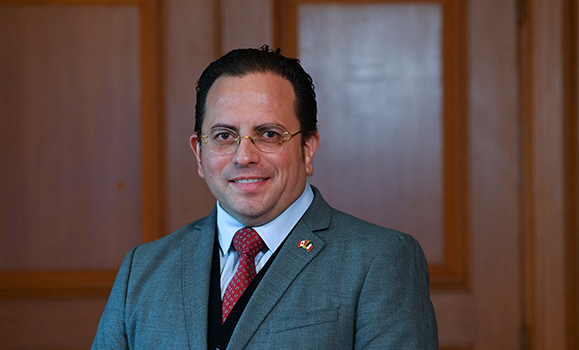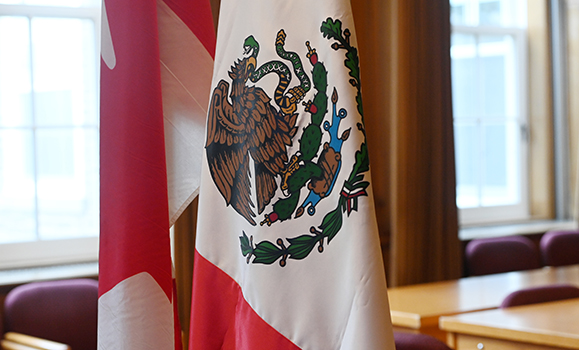During the recent fall harvest in Nova Scotia, Dr. Raluca Bejan’s thoughts turned to the hands behind the bounty — the foreign workers whose labour helps fuel the province’s agricultural success.Ěý
A social-work scholar motivated to create positive social change, Dr. Bejan has spent the past several years examining the treatment of migrant workers in Atlantic Canada, including the policies designed to safeguard their working and living conditions under the (ł§´ˇ°Â±Ę).ĚýĚý
The bilateral SAWP initiative between Canada and Mexico was established in 1974, building on a preexisting agreement with Caribbean countries. The program enables Canada’s agricultural sector to hire temporary workers when qualified local workers are unavailable.ĚýĚý
Now, a Memorandum of Understanding (MOU) signed between Dalhousie and the Government of Mexico in October will allow Dr. Bejan’s research to better inform policy that guides the SAWP and its on-the-ground implementation in the Maritimes.Ěý
“What we hope to do through this formalized collaboration is to conduct more community research, with the aim of providing very specific recommendations to influence legislation around the program in terms of housing and occupational conditions,” says Dr. Bejan.ĚýĚý

Dr. Raluca Bejan leads research into policies that safeguard Mexican agricultural workers in Canada.
She says the agreement will add an Atlantic Canadian perspective to a research effort that has largely focused on the implementation of the SAWP in British Columbia, Ontario, and Quebec.ĚýĚý
A growing workforce
She underscores that the research has grown more urgent in recent years, as Atlantic Canada’s agricultural sector increasingly leans on foreign workers to fill roles the local labour market is unable to support. To illustrate the point, she notes that in 2015 there were approximately 2,800 foreign workers in Nova Scotia, a number that jumped to 5,437 in 2023.ĚýĚý
A large proportion of the workers who make the trek to the province come from remote villages across Mexico and don’t speak English. As part of his role at the Consulate General of Mexico in Montreal, Felipe Alfonso González Lugo MĂ©ndez strives to provide migrant workers with a voice and to ensure their experiences align with regulations set forth in his country’s bilateral agreement with Canada.ĚýĚý
“This MOU is a very important milestone, because this is the first time ever that a Mexican consulate or our government has partnered with the academic sector on this specific subject in Canada,” says González Lugo, who is based in Montreal. “We believe that there will be a great impact in the midterm and in the long run as well.”ĚýĚý

Felipe Alfonso González Lugo Méndez, consul for protective services for Consulate General of Mexico in Montreal.
González Lugo says Dr. Bejan’s research has helped shape his understanding of the nuances of the SAWP program in Atlantic Canada. He sees the MOU as a natural extension of an already strong partnership with the researcher, initiated by a series of community reports she co-authored with colleagues at St. Thomas University — work he describes as extremely informative.ĚýĚý
From overcrowded housing to exploitation
The reports assessed conditions of Mexican workers in Prince Edward Island (2021), New Brunswick (2022), and Nova Scotia (2024), based on first-hand accounts gained through interviews. Each report revealed conditions that fail to meet the standards mandated by policies, alongside systemic problems and opportunities for improvement.ĚýĚý
The most recent report, “Falling Short: Troubles with the Seasonal Agricultural Worker Program in Nova Scotia,” was released in partnership with the Canadian Centre for Policy Alternatives. The document details issues like overcrowded housing and insufficient inspections of workers’ accommodations. It also describes problems arising from the piecemeal payment of workers, where compensation is provided for specific outcomes rather than time on the job — a system Dr. Bejan says leaves workers open to exploitation.ĚýĚý
González Lugo says their evidence-based findings about workers’ experiences help to inform Mexico’s negotiations to improve the program with the Government of Canada.Ěý
“During November’s Annual Review Meeting of the SAWP in Ottawa we discussed systemic challenges, such as geographic isolation, overcrowded accommodations and limited access to local services, particularly health care,” he says. “These concerns, raised by the Mexican delegation are particularly pertinent in the Atlantic Provinces, and I believe this MOU will bridge research and advocacy to help address these structural gaps.”
In large part, Dr. Bejan attributes shortfalls in the delivery of the SAWP to confusion over jurisdictional responsibility. While the federal government sets standards, policy enforcement is the domain of provincial authorities. By shining a light on gaps, she hopes that government and industry stakeholders can come together to address them.ĚýĚý
Dr. Bejan also highlights how employment contracts linking workers to a single employer for temporary residency can make them vulnerable and hesitant to voice concerns. She says the MOU will play a critical role in connecting her research team with Mexican workers in Nova Scotia. Even more importantly, she says consular officials will help explain the confidentiality of the research process, so workers feel comfortable sharing issues they face.Ěý Ěý

A Mexican flag on display at the signing at Dalhousie.Ěý
In return, González Lugo says the findings of Dr. Bejan and her team will inform the consulate’s work in serving its citizens in Canada.ĚýĚý
“The recommendations of the academic sector will be a very important tool for us to influence our policymaking, to improve bilateral arrangements with Canada, and to raise our own standards of protective services,” says González Lugo. “I believe it creates a pathway to improving the working and living conditions of Mexican migrant workers and exemplifies the strategic collaboration necessary to shape the future of circular migration policies.”ĚýĚý

